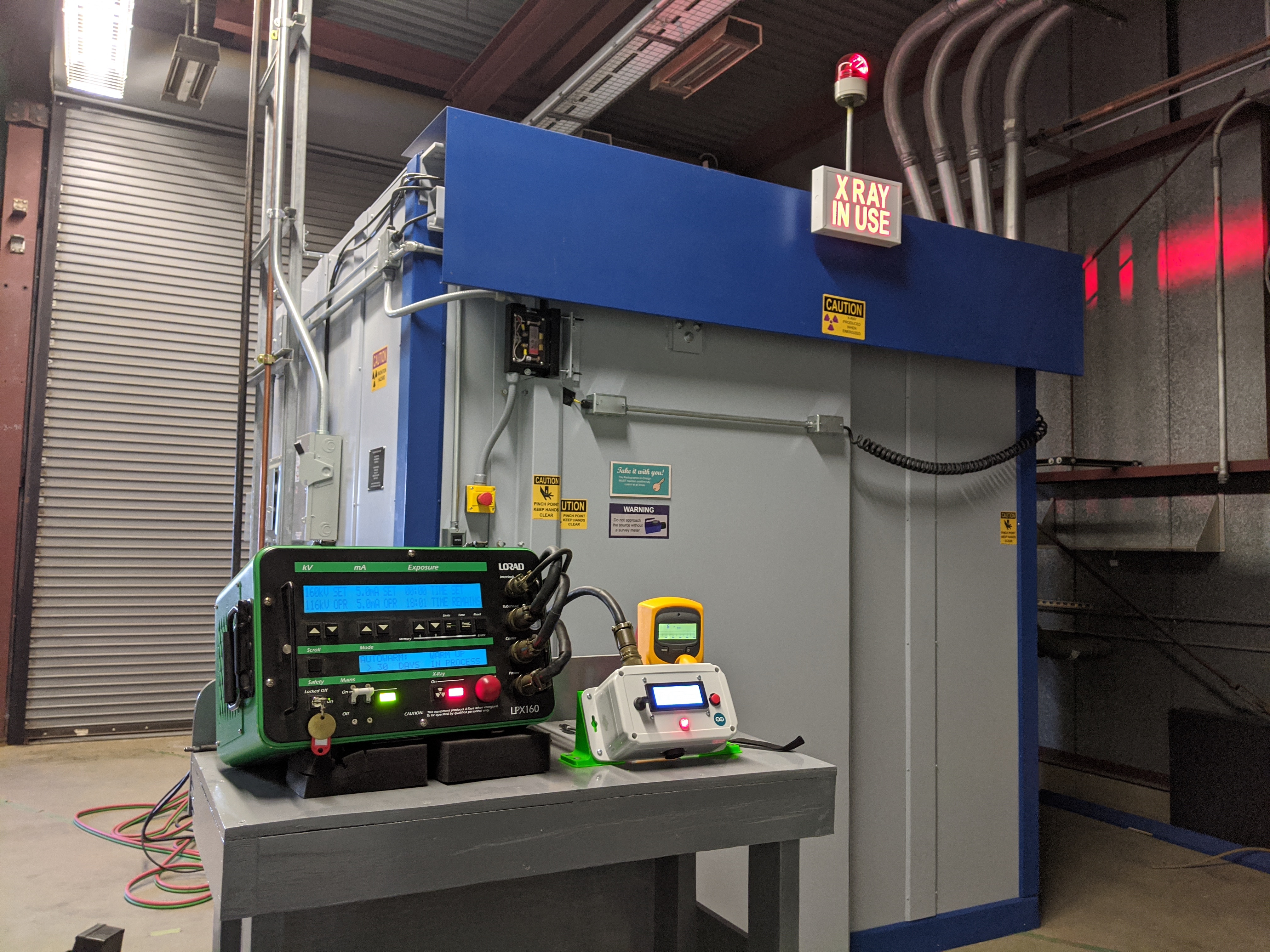|
Reflectometry
Reflectometry is a general term for the use of the reflection of waves or pulses at surfaces and interfaces to detect or characterize objects, sometimes to detect anomalies as in fault detection and medical diagnosis. There are many different forms of reflectometry. They can be classified in several ways: by the used radiation (electromagnetic, ultrasound, particle beams), by the geometry of wave propagation (unguided versus wave guides or cables), by the involved length scales (wavelength and penetration depth in relation to size of the investigated object), by the method of measurement (continuous versus pulsed, polarization resolved, ...), and by the application domain. Radiation sources *Electromagnetic radiation of widely varying wavelength is used in many different forms of reflectometry: ** Radar: Reflections of radiofrequency pulses are used to detect the presence and to measure the location and speed of objects such as aircraft, missiles, ships, vehicles. ** Lidar: ... [...More Info...] [...Related Items...] OR: [Wikipedia] [Google] [Baidu] |
X-ray Reflectometry
X-ray reflectivity (sometimes known as X-ray specular reflectivity, X-ray reflectometry, or XRR) is a surface-sensitive analytical technique used in chemistry, physics, and materials science to characterize Interface (matter), surfaces, thin films and multilayers.J. Als-Nielsen, D. McMorrow, ''Elements of Modern X-Ray Physics'', Wiley, New York, (2001). It is a form of reflectometry based on the use of X-rays and is related to the techniques of neutron reflectometry and ellipsometry. The basic principle of X-ray reflectivity is to reflect a beam of X-rays from a flat surface and to then measure the intensity of X-rays reflected in the specular direction (reflected angle equal to incident angle). If the interface is not perfectly sharp and smooth then the reflected intensity will deviate from that predicted by the law of Fresnel reflectivity. The deviations can then be analyzed to obtain the density profile of the interface normal to the surface. History The earliest measurements ... [...More Info...] [...Related Items...] OR: [Wikipedia] [Google] [Baidu] |
Reflection (physics)
Reflection is the change in direction of a wavefront at an interface between two different media so that the wavefront returns into the medium from which it originated. Common examples include the reflection of light, sound and water waves. The ''law of reflection'' says that for specular reflection (for example at a mirror) the angle at which the wave is incident on the surface equals the angle at which it is reflected. In acoustics, reflection causes echoes and is used in sonar. In geology, it is important in the study of seismic waves. Reflection is observed with surface waves in bodies of water. Reflection is observed with many types of electromagnetic wave, besides visible light. Reflection of VHF and higher frequencies is important for radio transmission and for radar. Even hard X-rays and gamma rays can be reflected at shallow angles with special "grazing" mirrors. Reflection of light Reflection of light is either '' specular'' (mirror-like) or '' diffuse'' (retai ... [...More Info...] [...Related Items...] OR: [Wikipedia] [Google] [Baidu] |
IEEE Transactions On Magnetics
''IEEE Transactions on Magnetics'' is a monthly peer-reviewed scientific journal that covers the basic physics of magnetism, magnetic materials, applied magnetics, magnetic devices, and magnetic data storage. The editor-in-chief is Amr Adly ( Cairo University, Egypt). Abstracting and indexing The journal is abstracted and indexed in the Science Citation Index, Current Contents/Physical, Chemical & Earth Sciences, Scopus, CSA databases, and EBSCOhost. According to the ''Journal Citation Reports'', the journal has a recent impact factor The impact factor (IF) or journal impact factor (JIF) of an academic journal is a type of journal ranking. Journals with higher impact factor values are considered more prestigious or important within their field. The Impact Factor of a journa ... of 2.1. References External links * {{Official website, 1=https://ieeexplore.ieee.org/xpl/RecentIssue.jsp?punumber=20 Physics journals Materials science journals Transactions on Magnet ... [...More Info...] [...Related Items...] OR: [Wikipedia] [Google] [Baidu] |
Neutron Diffraction
Neutron diffraction or elastic neutron scattering is the application of neutron scattering to the determination of the atomic and/or magnetic structure of a material. A sample to be examined is placed in a beam of Neutron temperature, thermal or cold neutron radiation, neutrons to obtain a diffraction pattern that provides information of the structure of the material. The technique is similar to X-ray diffraction but due to their different scattering properties, neutrons and X-rays provide complementary information: X-Rays are suited for superficial analysis, strong x-rays from synchrotron radiation are suited for shallow depths or thin specimens, while neutrons having high penetration depth are suited for bulk samples.Measurement of residual stress in materials using neutrons IAEA, ... [...More Info...] [...Related Items...] OR: [Wikipedia] [Google] [Baidu] |
Nondestructive Testing
Nondestructive testing (NDT) is any of a wide group of analysis techniques used in science and technology industry to evaluate the properties of a material, component or system without causing damage. The terms nondestructive examination (NDE), nondestructive inspection (NDI), and nondestructive evaluation (NDE) are also commonly used to describe this technology. Because NDT does not permanently alter the article being inspected, it is a highly valuable technique that can save both money and time in product evaluation, troubleshooting, and research. The six most frequently used NDT methods are eddy-current testing, eddy-current, magnetic-particle inspection, magnetic-particle, liquid penetrant testing, liquid penetrant, radiographic testing, radiographic, ultrasonic testing, ultrasonic, and Visual inspection, visual testing. NDT is commonly used in forensic engineering, mechanical engineering, petroleum engineering, electrical engineering, civil engineering, systems engineering, a ... [...More Info...] [...Related Items...] OR: [Wikipedia] [Google] [Baidu] |
Medical Ultrasonography
Medical ultrasound includes Medical diagnosis, diagnostic techniques (mainly medical imaging, imaging) using ultrasound, as well as therapeutic ultrasound, therapeutic applications of ultrasound. In diagnosis, it is used to create an image of internal body structures such as tendons, muscles, joints, blood vessels, and internal organs, to measure some characteristics (e.g., distances and velocities) or to generate an informative audible sound. The usage of ultrasound to produce visual images for medicine is called medical ultrasonography or simply sonography, or echography. The practice of examining pregnant women using ultrasound is called obstetric ultrasonography, and was an early development of clinical ultrasonography. The machine used is called an ultrasound machine, a sonograph or an echograph. The visual image formed using this technique is called an ultrasonogram, a sonogram or an echogram. Ultrasound is composed of sound waves with frequency, frequencies greater than ... [...More Info...] [...Related Items...] OR: [Wikipedia] [Google] [Baidu] |
Amplitude
The amplitude of a periodic variable is a measure of its change in a single period (such as time or spatial period). The amplitude of a non-periodic signal is its magnitude compared with a reference value. There are various definitions of amplitude (see below), which are all functions of the magnitude of the differences between the variable's extreme values. In older texts, the phase of a periodic function is sometimes called the amplitude. Definitions Peak amplitude and semi-amplitude For symmetric periodic waves, like sine waves or triangle waves, ''peak amplitude'' and ''semi amplitude'' are the same. Peak amplitude In audio system measurements, telecommunications and others where the measurand is a signal that swings above and below a reference value but is not sinusoidal, peak amplitude is often used. If the reference is zero, this is the maximum absolute value of the signal; if the reference is a mean value ( DC component), the peak amplitude is the maximum ab ... [...More Info...] [...Related Items...] OR: [Wikipedia] [Google] [Baidu] |
Acoustic Impedance
Acoustic impedance and specific acoustic impedance are measures of the opposition that a system presents to the acoustic flow resulting from an acoustic pressure applied to the system. The International System of Units, SI unit of acoustic impedance is the pascal-second per cubic metre (symbol Pa·s/m3), or in the MKS system of units, MKS system the rayl per square metre (Rayl/m2), while that of specific acoustic impedance is the pascal-second per metre (Pa·s/m), or in the MKS system the rayl (Rayl). There is a Mechanical–electrical analogies#Impedance analogies, close analogy with electrical impedance, which measures the opposition that a system presents to the electric current resulting from a voltage applied to the system. Mathematical definitions Acoustic impedance For a LTI system theory, linear time-invariant system, the relationship between the acoustic pressure applied to the system and the resulting acoustic volume flow rate through a surface perpendicular to the di ... [...More Info...] [...Related Items...] OR: [Wikipedia] [Google] [Baidu] |
Transducer
A transducer is a device that Energy transformation, converts energy from one form to another. Usually a transducer converts a signal in one form of energy to a signal in another. Transducers are often employed at the boundaries of automation, Measuring instrument, measurement, and control systems, where electrical signals are converted to and from other physical quantities (energy, force, torque, light, motion, position, etc.). The process of converting one form of energy to another is known as transduction. Types * Mechanical transducers convert physical quantities into mechanical outputs or vice versa; * Electrical transducers convert physical quantities into electrical outputs or signals. Examples of these are: ** a thermocouple that changes temperature differences into a small voltage; ** a linear variable differential transformer (LVDT), used to measure displacement (position) changes by means of electrical signals. Sensors, actuators and transceivers Transducers can be ... [...More Info...] [...Related Items...] OR: [Wikipedia] [Google] [Baidu] |
Ultrasound
Ultrasound is sound with frequency, frequencies greater than 20 Hertz, kilohertz. This frequency is the approximate upper audible hearing range, limit of human hearing in healthy young adults. The physical principles of acoustic waves apply to any frequency range, including ultrasound. Ultrasonic devices operate with frequencies from 20 kHz up to several gigahertz. Ultrasound is used in many different fields. Ultrasonic devices are used to detect objects and measure distances. Ultrasound imaging or sonography is often used in medicine. In the nondestructive testing of products and structures, ultrasound is used to detect invisible flaws. Industrially, ultrasound is used for cleaning, mixing, and accelerating chemical processes. Animals such as bats and porpoises use ultrasound for locating prey and obstacles. History Acoustics, the science of sound, starts as far back as Pythagoras in the 6th century BC, who wrote on the mathematical properties of String instrument ... [...More Info...] [...Related Items...] OR: [Wikipedia] [Google] [Baidu] |
Tympanometer
Tympanometry is an acoustic evaluation of the condition of the middle ear eardrum (tympanic membrane) and the conduction bones by creating variations of air pressure in the ear canal. Tympanometry is an objective test of middle-ear function. It is not a hearing test, but rather a measure of energy transmission through the middle ear. It is not a measure of eardrum or middle ear mobility. It is an acoustic measure, measured by a microphone, as part of the ear canal probe, inserted into the ear canal. The test should not be used to assess the sensitivity of hearing and the results of this test should always be viewed in conjunction with pure tone audiometry. Tympanometry is a valuable component of the audiometric evaluation. In evaluating hearing loss, tympanometry permits a distinction between sensorineural and conductive hearing loss, when evaluation is not apparent via Weber and Rinne testing. Furthermore, in a primary care setting, tympanometry can be helpful in making the ... [...More Info...] [...Related Items...] OR: [Wikipedia] [Google] [Baidu] |






